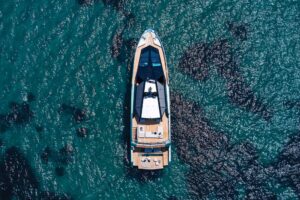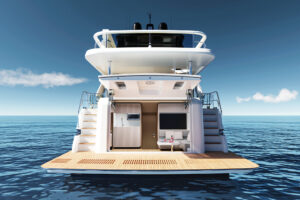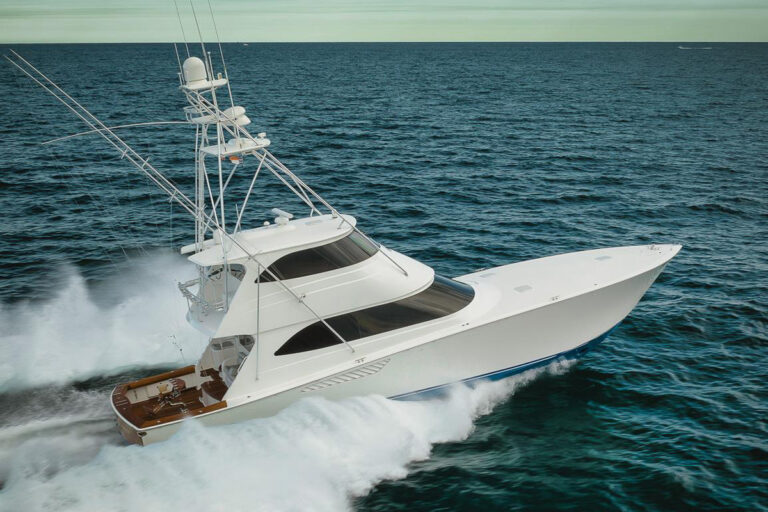There is a widely held belief that a true sportfishing war wagon must have the mystical ability to “raise fish. Not only should record-size fish be attracted to the waters around the boat, but something-perhaps the hull’s resonance-should put them in the mood to be caught.
Fussing with a successful product can be a challenge, and few boats have enjoyed as solid a reputation for performance and seakeeping as Bertram’s 54-foot convertible. More than 150 have been delivered since the model’s introduction in 1981. I must confess I was disappointed when I heard she would be replaced, after The Ferretti Group purchased Bertram in 1998 and set about revamping the product line. I have piloted a number of 54s over the years and consider her one of the best-running boats in her class, an icon of modern convertible design that I thought could not possibly be improved.
After running the new 570 Convertible, I can say the 54’s passing will not be mourned for long.
Adding a bit of length to a planing hull form without adding significant weight typically has a positive effect on performance, and there is no better example of this than the 570, which is the 54 with 3 feet added to her transom. She rises more easily to a plane than the 54 and at speed trims slightly less, about 4 degrees. Water separates cleanly from her chine roughly amidships. The result is the familiar, soft, dry ride of the 54-and then some.
Hull number one was fitted with 1,300 hp MANs, the leanest engine package offered in terms of horsepower. Even so, at more than half-load with six people aboard and a full tower, I recorded a top speed of 36 knots. This is a smidgen faster than a 54 I tested in 1998 with similar power and no tower. At 2100 rpm, the 570 cruised at just less than 33 knots. The higher horsepower Caterpillar and MTU options are worth considering, and the folks at Bertram say speeds of more than 40 knots could be possible.
Half of fish’n good is look’n good, and the 570 does. Her lines incorporate the new Bertram styling cues, but her house is set back a bit more than that on Bertram’s 510 and 450 models. This design offers a more pleasing balance to the conservative eye. While the 510 and 450 are attractive, the 570 has a more conservative tone and a somewhat aggressive appearance reminiscent of the 54. As has always been the case aboard Bertrams, the bow rail is stout and handrails are positioned where needed. A toerail borders the 570’s 14-inch side decks.
The 570’s cockpit is bit larger than its predecessor, and anglers will be pleased to find a bulkhead tackle center with a sink, a freezer and a live well. A removable fishbox in the sole is fitted with a macerator and drains overboard. There is also an insulated transom fishbox, and a door with a gate.
Stowage lockers to port and starboard conceal shore service inlets and two Glendinning Cablemaster shorepower systems, an attractive standard feature. There is stowage under the gunwales for gaffs and boat hooks, and fresh- and saltwater washdowns are fitted. A clever perimeter drainage system expresses water aft to large transom scuppers with backwash flaps.
The flying bridge reflects current trends in custom fish boat design with a hydraulically actuated pop-up electronics console and a pod-style helm with single-lever controls. The pop-up console is a $9,950 option serious anglers should consider. Sight lines from the helm and companion seating are excellent.
The 570’s interior seems just the right blend of conservative fish boat logic and Italian flair. The quality of the joinerwork is excellent, and the cherry is available in a gloss or satin finish. The saloon has a sofa with a section that faces aft, an arrangement I like because it allows a view of the cockpit and beyond. A built-in entertainment center, a wet bar and the main electrical panels are to starboard.
A sub-panel for the forward accommodations is in the entry to the forward passageway. Sub-panels reduce the amount of unprotected wire from the source to the load, which enhances safety and reduces weight.
Two galley arrangements offer a domestic-style upright refrigerator or an open arrangement with under-counter Sub-Zero drawer-style refrigeration. I prefer the latter, as it appears to have a bit more stowage and seems less formal. In both arrangements, there is a dinette adjacent to the galley and rod stowage in the overhead.
The 570’s three-stateroom, three-head layout is one of the best I have seen on a convertible in this class. Berths are not shoehorned in, and there is plenty of stowage. The master has a queen island berth, a hanging locker and a built-in entertainment center. The guest cabin, opposite, has two side-by-side berths instead of the more common upper-and-lower berths. The guest stateroom forward has an island berth, two hanging lockers and a built-in entertainment center. The alternate arrangement has single berths.
Bertram has always been innovative in its use of structural materials and was one of the first production boatbuilders to use coring and exotic reinforcements. The 570’s solid bottom laminate is handlaid with stitched multidirectional reinforcements and a combination of polyester and vinylester resin. Closed-cell foam coring stiffens the hull sides, exterior decks and superstructure. Stringers are laminated in fiberglass over high-density structural foam. Bulkheads and web frames are similarly cored.
The 570, like Bertram’s other new designs, includes a number of significant practical improvements. A PVC rub rail is used instead of the aluminum affair that tends to shed paint on older Bertrams. Owners will appreciate the frameless windows for the same reason.
Access to the engineroom is from the cockpit. While Bertram has never compromised on systems or structure, at times its engineroom finishes have fallen a bit short. This is no longer the case, thanks to a high-gloss Awlgrip finish. Engines are segregated forward, and ancillary systems are aft in an adjoining space. This layout results in excellent access to both. Engine removal hatches are in the saloon sole, and machinery removal hatches are in the cockpit.
Fuel is carried in a single fiberglass tank that extends from the bilge to the overhead in the engineroom. I generally prefer split-tank arrangements, which allow the skipper some control of longitudinal trim, but the 570’s fuel placement seems ideal and no tinkering is necessary.
If you have the sense that I was particularly impressed with the 570, you’re right. As the owner of an older Bertram 37, I am one of the builder’s most difficult sells. The new designs have a European influence that old fans like me took some time to warm up to, but the new-look Bertrams and Ferretti’s commitment to building them right have won me over.
Contact: Bertram Yacht, Inc., (305) 633-8011; fax (305) 635-1388; www.bertram.com.









